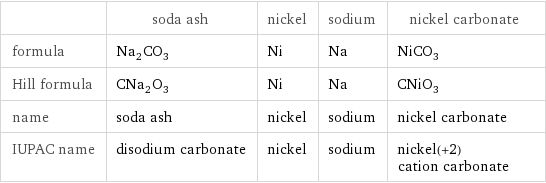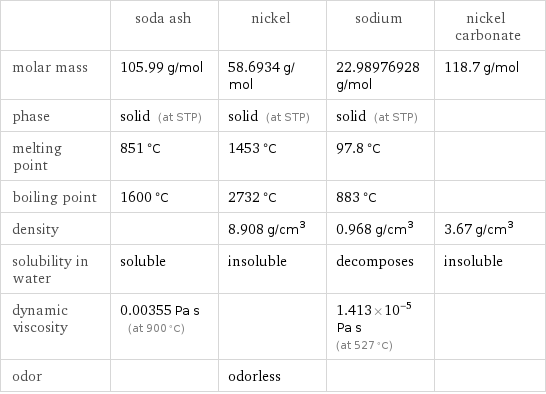Input interpretation

Na_2CO_3 soda ash + Ni nickel ⟶ Na sodium + NiCO_3 nickel carbonate
Balanced equation

Balance the chemical equation algebraically: Na_2CO_3 + Ni ⟶ Na + NiCO_3 Add stoichiometric coefficients, c_i, to the reactants and products: c_1 Na_2CO_3 + c_2 Ni ⟶ c_3 Na + c_4 NiCO_3 Set the number of atoms in the reactants equal to the number of atoms in the products for C, Na, O and Ni: C: | c_1 = c_4 Na: | 2 c_1 = c_3 O: | 3 c_1 = 3 c_4 Ni: | c_2 = c_4 Since the coefficients are relative quantities and underdetermined, choose a coefficient to set arbitrarily. To keep the coefficients small, the arbitrary value is ordinarily one. For instance, set c_1 = 1 and solve the system of equations for the remaining coefficients: c_1 = 1 c_2 = 1 c_3 = 2 c_4 = 1 Substitute the coefficients into the chemical reaction to obtain the balanced equation: Answer: | | Na_2CO_3 + Ni ⟶ 2 Na + NiCO_3
Structures

+ ⟶ +
Names

soda ash + nickel ⟶ sodium + nickel carbonate
Equilibrium constant
![Construct the equilibrium constant, K, expression for: Na_2CO_3 + Ni ⟶ Na + NiCO_3 Plan: • Balance the chemical equation. • Determine the stoichiometric numbers. • Assemble the activity expression for each chemical species. • Use the activity expressions to build the equilibrium constant expression. Write the balanced chemical equation: Na_2CO_3 + Ni ⟶ 2 Na + NiCO_3 Assign stoichiometric numbers, ν_i, using the stoichiometric coefficients, c_i, from the balanced chemical equation in the following manner: ν_i = -c_i for reactants and ν_i = c_i for products: chemical species | c_i | ν_i Na_2CO_3 | 1 | -1 Ni | 1 | -1 Na | 2 | 2 NiCO_3 | 1 | 1 Assemble the activity expressions accounting for the state of matter and ν_i: chemical species | c_i | ν_i | activity expression Na_2CO_3 | 1 | -1 | ([Na2CO3])^(-1) Ni | 1 | -1 | ([Ni])^(-1) Na | 2 | 2 | ([Na])^2 NiCO_3 | 1 | 1 | [NiCO3] The equilibrium constant symbol in the concentration basis is: K_c Mulitply the activity expressions to arrive at the K_c expression: Answer: | | K_c = ([Na2CO3])^(-1) ([Ni])^(-1) ([Na])^2 [NiCO3] = (([Na])^2 [NiCO3])/([Na2CO3] [Ni])](../image_source/7de2813003d84bad208ea8560bb8cfe2.png)
Construct the equilibrium constant, K, expression for: Na_2CO_3 + Ni ⟶ Na + NiCO_3 Plan: • Balance the chemical equation. • Determine the stoichiometric numbers. • Assemble the activity expression for each chemical species. • Use the activity expressions to build the equilibrium constant expression. Write the balanced chemical equation: Na_2CO_3 + Ni ⟶ 2 Na + NiCO_3 Assign stoichiometric numbers, ν_i, using the stoichiometric coefficients, c_i, from the balanced chemical equation in the following manner: ν_i = -c_i for reactants and ν_i = c_i for products: chemical species | c_i | ν_i Na_2CO_3 | 1 | -1 Ni | 1 | -1 Na | 2 | 2 NiCO_3 | 1 | 1 Assemble the activity expressions accounting for the state of matter and ν_i: chemical species | c_i | ν_i | activity expression Na_2CO_3 | 1 | -1 | ([Na2CO3])^(-1) Ni | 1 | -1 | ([Ni])^(-1) Na | 2 | 2 | ([Na])^2 NiCO_3 | 1 | 1 | [NiCO3] The equilibrium constant symbol in the concentration basis is: K_c Mulitply the activity expressions to arrive at the K_c expression: Answer: | | K_c = ([Na2CO3])^(-1) ([Ni])^(-1) ([Na])^2 [NiCO3] = (([Na])^2 [NiCO3])/([Na2CO3] [Ni])
Rate of reaction
![Construct the rate of reaction expression for: Na_2CO_3 + Ni ⟶ Na + NiCO_3 Plan: • Balance the chemical equation. • Determine the stoichiometric numbers. • Assemble the rate term for each chemical species. • Write the rate of reaction expression. Write the balanced chemical equation: Na_2CO_3 + Ni ⟶ 2 Na + NiCO_3 Assign stoichiometric numbers, ν_i, using the stoichiometric coefficients, c_i, from the balanced chemical equation in the following manner: ν_i = -c_i for reactants and ν_i = c_i for products: chemical species | c_i | ν_i Na_2CO_3 | 1 | -1 Ni | 1 | -1 Na | 2 | 2 NiCO_3 | 1 | 1 The rate term for each chemical species, B_i, is 1/ν_i(Δ[B_i])/(Δt) where [B_i] is the amount concentration and t is time: chemical species | c_i | ν_i | rate term Na_2CO_3 | 1 | -1 | -(Δ[Na2CO3])/(Δt) Ni | 1 | -1 | -(Δ[Ni])/(Δt) Na | 2 | 2 | 1/2 (Δ[Na])/(Δt) NiCO_3 | 1 | 1 | (Δ[NiCO3])/(Δt) (for infinitesimal rate of change, replace Δ with d) Set the rate terms equal to each other to arrive at the rate expression: Answer: | | rate = -(Δ[Na2CO3])/(Δt) = -(Δ[Ni])/(Δt) = 1/2 (Δ[Na])/(Δt) = (Δ[NiCO3])/(Δt) (assuming constant volume and no accumulation of intermediates or side products)](../image_source/ad6b2748ec9afa38d4496268ee74579c.png)
Construct the rate of reaction expression for: Na_2CO_3 + Ni ⟶ Na + NiCO_3 Plan: • Balance the chemical equation. • Determine the stoichiometric numbers. • Assemble the rate term for each chemical species. • Write the rate of reaction expression. Write the balanced chemical equation: Na_2CO_3 + Ni ⟶ 2 Na + NiCO_3 Assign stoichiometric numbers, ν_i, using the stoichiometric coefficients, c_i, from the balanced chemical equation in the following manner: ν_i = -c_i for reactants and ν_i = c_i for products: chemical species | c_i | ν_i Na_2CO_3 | 1 | -1 Ni | 1 | -1 Na | 2 | 2 NiCO_3 | 1 | 1 The rate term for each chemical species, B_i, is 1/ν_i(Δ[B_i])/(Δt) where [B_i] is the amount concentration and t is time: chemical species | c_i | ν_i | rate term Na_2CO_3 | 1 | -1 | -(Δ[Na2CO3])/(Δt) Ni | 1 | -1 | -(Δ[Ni])/(Δt) Na | 2 | 2 | 1/2 (Δ[Na])/(Δt) NiCO_3 | 1 | 1 | (Δ[NiCO3])/(Δt) (for infinitesimal rate of change, replace Δ with d) Set the rate terms equal to each other to arrive at the rate expression: Answer: | | rate = -(Δ[Na2CO3])/(Δt) = -(Δ[Ni])/(Δt) = 1/2 (Δ[Na])/(Δt) = (Δ[NiCO3])/(Δt) (assuming constant volume and no accumulation of intermediates or side products)
Chemical names and formulas

| soda ash | nickel | sodium | nickel carbonate formula | Na_2CO_3 | Ni | Na | NiCO_3 Hill formula | CNa_2O_3 | Ni | Na | CNiO_3 name | soda ash | nickel | sodium | nickel carbonate IUPAC name | disodium carbonate | nickel | sodium | nickel(+2) cation carbonate
Substance properties

| soda ash | nickel | sodium | nickel carbonate molar mass | 105.99 g/mol | 58.6934 g/mol | 22.98976928 g/mol | 118.7 g/mol phase | solid (at STP) | solid (at STP) | solid (at STP) | melting point | 851 °C | 1453 °C | 97.8 °C | boiling point | 1600 °C | 2732 °C | 883 °C | density | | 8.908 g/cm^3 | 0.968 g/cm^3 | 3.67 g/cm^3 solubility in water | soluble | insoluble | decomposes | insoluble dynamic viscosity | 0.00355 Pa s (at 900 °C) | | 1.413×10^-5 Pa s (at 527 °C) | odor | | odorless | |
Units
